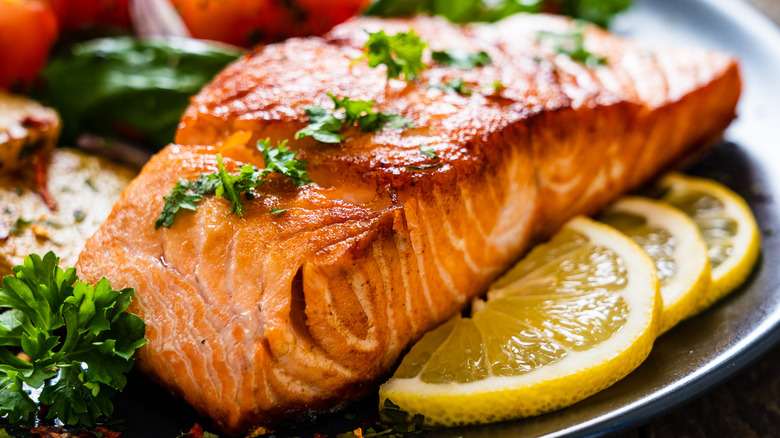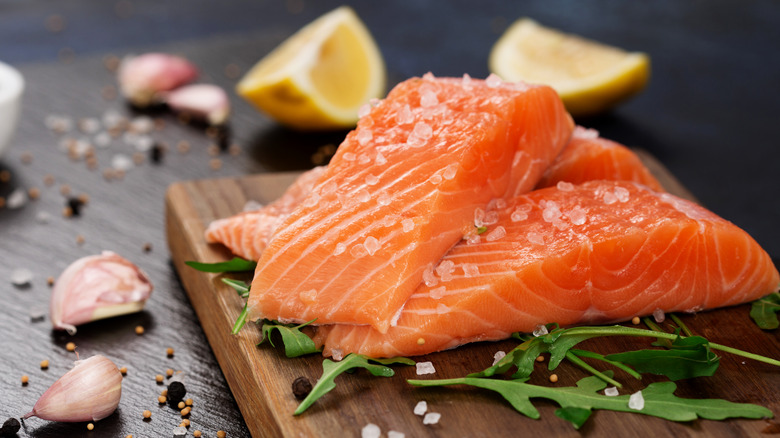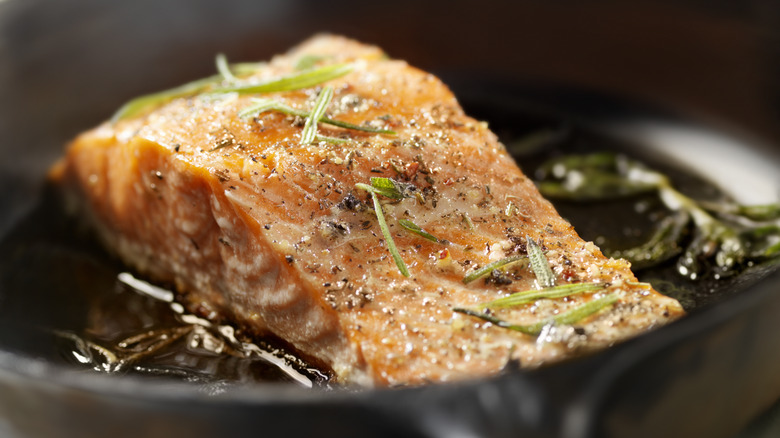Brine Your Salmon If You're Tired Of The White Ooze
If you've ever cooked salmon at home, you've likely encountered a white substance that seeps from the fish during cooking. This substance, called albumin, is a protein that's in liquid form in raw salmon. As the fish cooks, the albumin solidifies and oozes out, forming a semi-solid, semi-liquid slime. The good news is that albumin is completely safe to eat and is tasteless, so it's not a significant concern. The bad news is that it's pretty much unavoidable: All salmon, whether farmed or wild, and regardless of its quality or price, contains albumin.
Fortunately, for home cooks who prefer their salmon without this white goop, there's a way to prevent the albumin from forming that unappetizing slime. The solution involves using salt and, sometimes, water. You'll need to brine your salmon, and there are two methods to do this: dry or wet brining. While these methods work a bit differently, the end result is the same: less albumin.
Dry brine your salmon with salt to reduce albumin
One method for preventing albumin in salmon is to dry brine it. This process involves coating your salmon with a moderate amount of salt — perhaps a teaspoon or so for a small-to-medium fillet. (Be cautious with recipes that call for a cup or more of salt: those are typically for smoking or curing salmon, but here we're focusing on pan-frying salmon.) It's best to let your fillets sit for a while; a few hours to overnight is ideal, but this method will still reduce albumin even if the salt only has 15 minutes to work.
When you're ready to cook, you should rinse the salmon. This step removes excess salt, but it also plays a crucial role in the process. The salt draws albumin (and other liquids) out of the salmon fillet's cells, which will then be washed away when you rinse before cooking. And although it might seem counterintuitive, salting the salmon doesn't necessarily make it less moist. In fact, the end product should actually be pretty juicy, and as a bonus, salt can help to lock more flavor in.
Wet brining might help keep your salmon tender
Dry brining isn't your only option — wet brining is also effective in preventing albumin from surfacing on your seared salmon. Making a wet brine is simple: mix about a tablespoon of salt into each cup of water you need, and immerse the salmon in this salty solution. Even a brief 15-minute soak in the brine can be effective.
The science behind wet brining is slightly different from that of dry brining. The wet brine works by breaking down and loosening the muscle fibers on the exterior of the fillet. Therefore, when cooking the salmon, these looser fibers don't constrict excessively and squeeze out the albumin, as they would in unbrined salmon. Some chefs prefer this method because it distributes the salt more evenly, unlike dry brining, where you might accidentally create salt clumps on parts of the fish. Some cooks argue that wet brining is better for lighter meats like fish and chicken (reserving dry brining for heavier meats like beef) to prevent them from drying out. However, there's no definitive "correct" answer, as dry brining may help the meat retain more flavor by reducing moisture levels that might otherwise dilute it.
Lastly, it's worth noting that brining isn't the only way to combat albumin ooze. For example, cooking salmon at a lower temperature and avoiding overcooking it are also good strategies. Combine these techniques with a good brine, and your white, oozy salmon will be a thing of the past.


